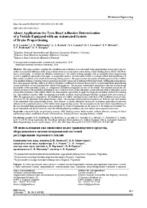| dc.contributor.author | Leontiev, D. N. | |
| dc.contributor.author | Nikitchenko, I. N. | |
| dc.contributor.author | Ryzhyh, L. A. | |
| dc.contributor.author | Lomaka, S. I. | |
| dc.contributor.author | Voronkov, O. I. | |
| dc.contributor.author | Hritsuk, I. V. | |
| dc.contributor.author | Pylshchyk, S. V. | |
| dc.contributor.author | Kuripka, O. V. | |
| dc.coverage.spatial | Минск | ru |
| dc.date.accessioned | 2019-10-21T12:35:49Z | |
| dc.date.available | 2019-10-21T12:35:49Z | |
| dc.date.issued | 2019 | |
| dc.identifier.citation | About Application the Tyre-Road Adhesion Determination of a Vehicle Equipped with an Automated System of Brake Proportioning = Об использовании сил сцепления колес транспортного средства, оборудованного автоматизированной системой регулирования тормозного усилия / D. N. Leontiev [и др.] // Наука и техника. – 2019. – № 5. – С. 401-408. | ru |
| dc.identifier.uri | https://rep.bntu.by/handle/data/58117 | |
| dc.description.abstract | The paper considers a method for calculation and evaluation of an automated brake proportioning system and it also describes assessment of efficiency while using cohesion forces of an automated system during vehicle braking process (MAZ 256200 taken as an example). A method for efficiency estimation of the vehicle braking equipped with an automated brake proportioning system is graphically presented in the paper. A comparable analysis has been made in order to evaluate vehicle braking efficiency in three various conditions of its wheel motion during braking process. The paper contains description of braking processes for a vehicle at its idealized braking, at braking with an operating automated system and at braking with blocked wheels. Mathematical dependences have been proposed and they make it possible to calculate a coefficient of cohesion forces used by an automated brake proportioning system on the basis of time parameters for vehicle braking process. The proposed mathematical dependences take into account design peculiarities of the automated system, i.e. a diagram of modulator arrangement on axes of the vehicle. The executed analysis for calculation accuracy of the coefficient pertaining to use of cohesion forces of the automated system with and without taking into accout rolling force resistance of the vehicle wheels has demonstrated a possibility to apply the proposed calculation methods for carrying out auto-technical expertise while investigating road-traffic accidents involving transport facilities equipped with such systems as ABS. The paper proposes a dependence for identification of a vehicle braking distance on the basis of the coefficient on use of cohesion forces by the automated brake proportioning system. The executed experimental investigations on both test and serial models of the automated brake proportioning system have allowed to justify theoretical discussions concerning application of tyre-road adhesion in the operational process of the vehicle brake proportioning system. The investigation results have shown high efficiency of the test automated brake proportioning system developed by Chair of Automobiles in the name of A. B. Hredescul at Kharkiv National Automobile and Road University under the following braking conditions: dry road surface and compacted snow cover. | ru |
| dc.language.iso | en | ru |
| dc.publisher | БНТУ | ru |
| dc.title | About Application the Tyre-Road Adhesion Determination of a Vehicle Equipped with an Automated System of Brake Proportioning | ru |
| dc.title.alternative | Об использовании сил сцепления колес транспортного средства, оборудованного автоматизированной системой регулирования тормозного усилия | ru |
| dc.type | Article | ru |
| dc.identifier.doi | 10.21122/2227-1031-2019-18-5-401-408 | |
| local.description.annotation | В статье рассмотрен метод расчета и оценки автоматизированной системы регулирования тормозного усилия, а также выполнена оценка эффективности использования силы сцепления автоматизированной системой в процессе торможения колесного транспортного средства (на примере автобуса МАЗ 256200). Графически представлен и обоснован способ оценки эффективности торможения транспортного средства, оборудованного автоматизированной системой регулирования тормозного усилия. Проведен сравнительный анализ эффективности торможения транспортного средства в трех разных условиях движения его колес при торможении. Описаны процессы торможения при идеализированном торможении, торможении при работе автоматизированной системы, а также при торможении транспортного средства с заблокированными колесами. Предложены математические зависимости, позволяющие рассчитать коэффициент использования силы сцепления автоматизированной системой регулирования тормозного усилия на основе временных параметров процесса торможения транспортного средства. Предложенные математические зависимости учитывают особенности конструкции автоматизированной системы, т. е. схему расположения модуляторов на осях колесного транспортного средства. Выполненный анализ точности расчетов коэффициента использования силы сцепления автоматизированной системой с учетом и без учета сил сопротивления качения колес транспортного средства показал возможность использования предложенных методов расчета в практике автотехнических экспертиз при расследовании дорожно-транспортных происшествий с участием транспортных средств, оборудованных такими системами, как ABS. Предложена зависимость определения тормозного пути колесного транспортного средства на основе коэффициента использования силы сцепления автоматизированной системой регулирования тормозного усилия. Выполненные экспериментальные исследования опытного и серийного образцов автоматизированной системы позволили подтвердить теоретические рассуждения в отношении использования сил сцепления в процессе работы автоматизированной системы регулирования тормозного усилия колесного транспортного средства. Результаты исследований показали высокую эффективность работы экспериментальной автоматизированной системы, разработанной на кафедре автомобилей имени А. Б. Гредескула Харьковского национального автомобильно-дорожного университета, в условиях торможения транспортного средства на сухом асфальтовом и укатанном снежном покрытиях. | ru |

